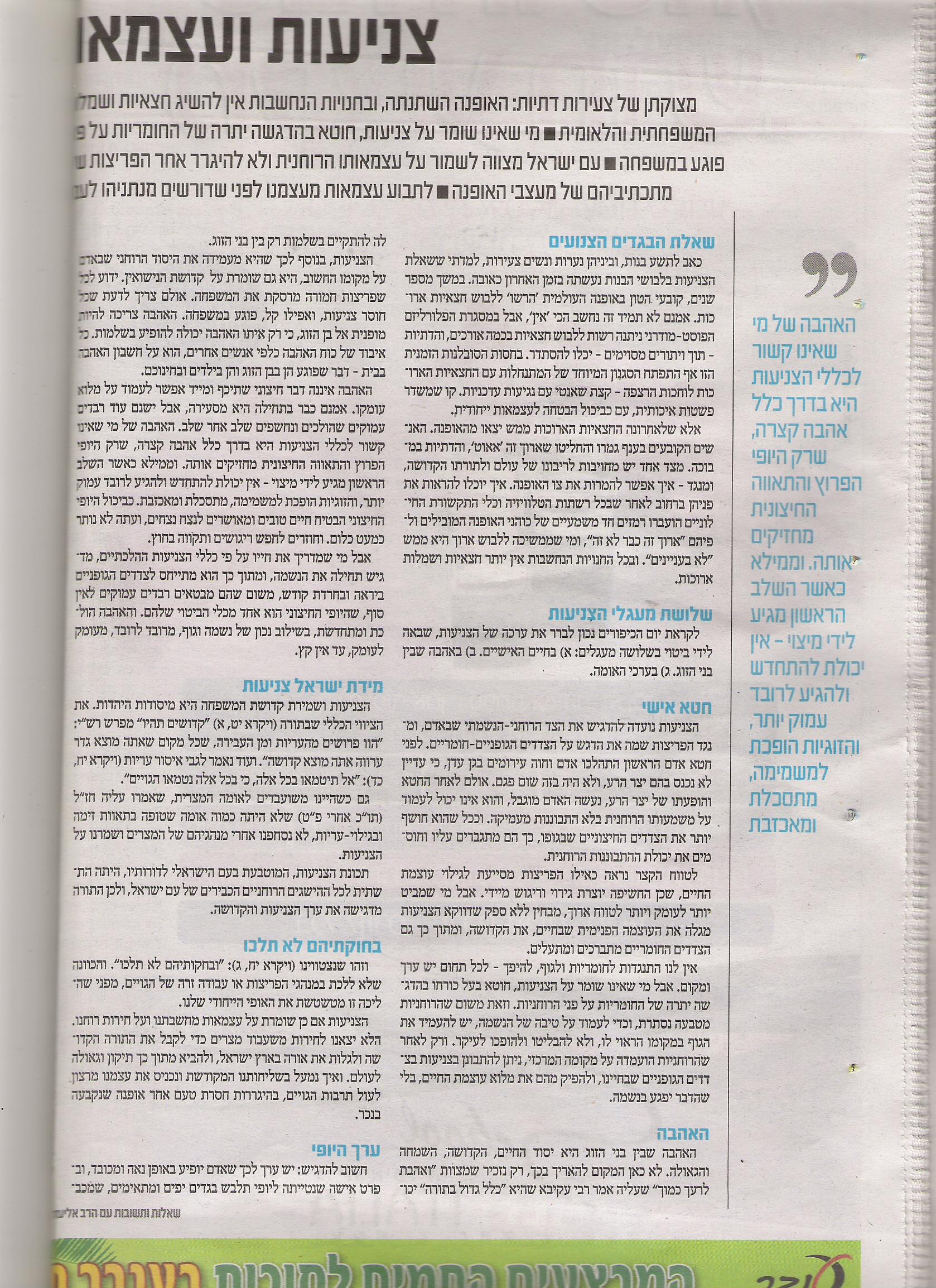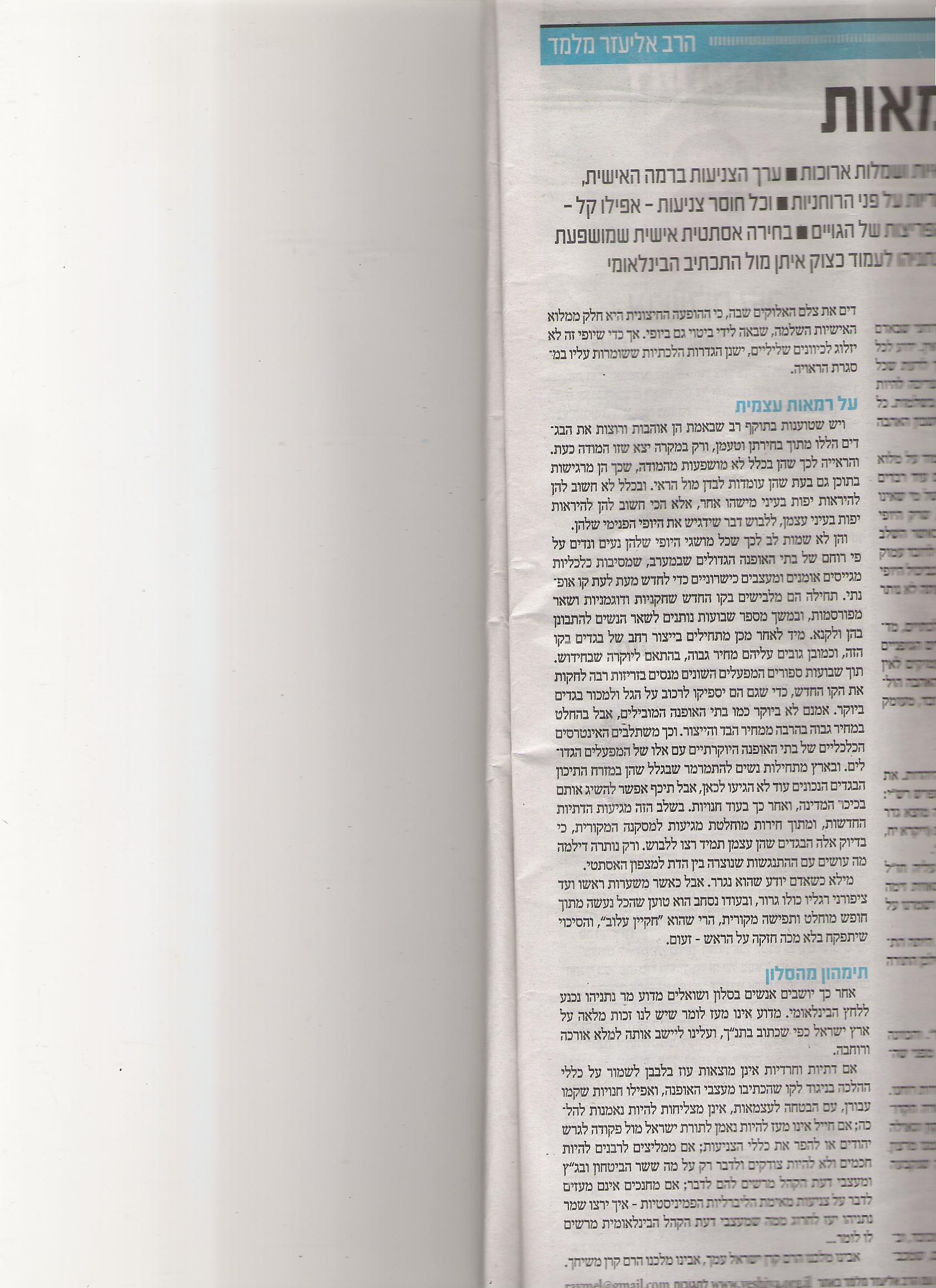 I removed what I quoted earlier, and have added the original article (thanks to Faith/Emuna for sending it to me). Bloggers have to sleep sometime, but in short, the article is mostly about tzniut and how people are not aware of how they let fashion dictate their styles. If long skirts are out, many religious women will find a way not to wear them.
I removed what I quoted earlier, and have added the original article (thanks to Faith/Emuna for sending it to me). Bloggers have to sleep sometime, but in short, the article is mostly about tzniut and how people are not aware of how they let fashion dictate their styles. If long skirts are out, many religious women will find a way not to wear them.
 It seems that R. Melamed does not go so far as to blame the girls for Israel’s political problems. That part seemed to be tacked on at the end. I’ll quote commenter Sarah:
It seems that R. Melamed does not go so far as to blame the girls for Israel’s political problems. That part seemed to be tacked on at the end. I’ll quote commenter Sarah:
It seemed to me like he’s saying, “If you don’t stick by what you claim to be your principles, how can you ask someone else to stick by what they claim are are their principles?” Maybe it’s still not a great argument, but I don’t think he’s saying that lack of tzniut is the causal factor or that the political situation is a direct result–just that something comparable is going on.
ri-i-ight.
Wow. I think my 3-year-old could come up with better logic than this. I hope she can. My 1.5 year old can’t, but then again, he’s still not making sentences that go much beyond 3 words.
I would dismiss it as insane, but unfortnately this man has many disciples.
I just skimmed through some of the original Hebrew article in BaSheva, and I didn’t read it the way this is portraying it. It seemed to me like he’s saying, “If you don’t stick by what you claim to be your principles, how can you ask someone else to stick by what they claim are are their principles?” Maybe it’s still not a great argument, but I don’t think he’s saying that lack of tzniut is the causal factor or that the political situation is a direct result–just that something comparable is going on.
Sarah and Leah (not GG): You may be right: Here is a link to Srugim’s take on the article, including many quotes
Hmmmm- I agree that there is an immodesty issue- which is a self-control problem. But to associate it with Mr. Netanyahu’s political decisions is reaching.
Are you sure nothing got lost in translation, b/c this logic is hard to follow.
May be he is pointing out a similarity (not a causation). Just like the women square their religious outlook with aesthetic sensibilities, so does Netanyahu makes his ideology fit with Obama’s outlook.
And of course to tie it into tzniut and find an excuse to give women more mussar (sp?) . . . Once one of my haredi relatives explained to me that haredi women have so few things to take pleasure in, so their love of (modest) clothes seems like a relatively minor pleasure. Of course, that was said to me around 20 years ago . . .and now some folks are even more extreme.
Miriam, “haredi” is a very broad term, and I know plenty of haredi women that do not lack ways to indulge themselves. Actually, I would say that parts of the haredi world have become more open-minded in the last 20 years, not less so.
BTW, Rav Melamed is far from Haredi and his audience is largely dati-leumi (or hardal)particularly in Yesha.
hmmmn. maybe it’s because my dress isn’t influenced as much by fads as by what makes me comfortable (I’m horrendously uncomfortable in long – or even 3/4 sleeves in the summer and I hate the feel of skirts so much that whenever I get home, I immediately change into pants) that I don’t feel the association rings true.
I would assume that Bibi would feel terribly uncomfortable about selling out his people and would rush to stop doing so as soon as he possibly could even if he had to look like he was doing so for outward appearances…
In the history of fashion, long skirts were almost never “in”. Religious women wore long skirts because they wanted to, and found them either in mainstream stores, or stores that cater to religious women. Nothing has changed in that regard. If Rav Melamed has noticed more women wearing less-long skirts, maybe it’s for other reasons. Like a growing distaste for this type of religious fare?
Miriam, thanks for replying. Do you mean recent history of fashion (say the last hundred years)? There was an old picture of frum women that I saw recently, and the women were all wearing short skirts. If you wanted a long skirt you had to sew it, or have it sewn for you.
I recently read this in hebrew, and one point I saw was that he was saying: “as the father of 9 girls….”. I think that at the beginning he is expressing some frustation about going shopping with his daughter, or trying to get them clothes. For many years it was very easy to get long skirts and to wear a certain “settlement style”. It seems that to some extent as a father he was frustrated that finding appropriate clothes has become some much harder, since styles changed. Maybe what he writes reflects what is going on in his own home with his teenagers. I looked at the young girls in the shul. Many were wearing a short skirt with some sort of underskirt to make it go past their knees (or decorative trousers) and tops also in 2 layers. Wearing 2 layers in order to get enough bits covered is much less comfortable, which makes wearing ztniut clothese more comlex (as well as more expensive, since you have to buy 4 parts and not 2)